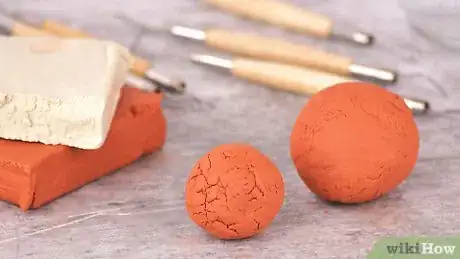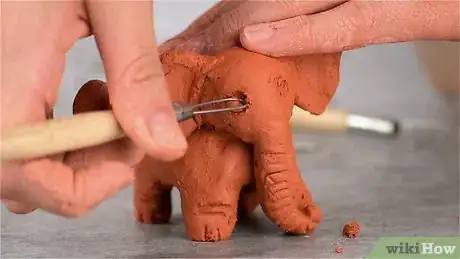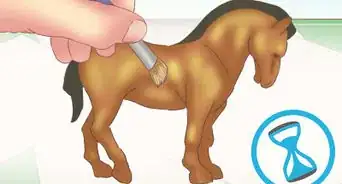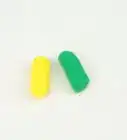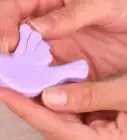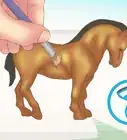This article was co-authored by wikiHow staff writer, Janice Tieperman. Janice is a professional and creative writer who has worked at wikiHow since 2019. With both a B.A. and M.A. in English from East Stroudsburg University, she has a passion for writing a wide variety of content for anyone and everyone. In her free time, you can find her working on a new crochet pattern, listening to true crime podcasts, or tackling a new creative writing project.
There are 13 references cited in this article, which can be found at the bottom of the page.
The wikiHow Video Team also followed the article's instructions and verified that they work.
This article has been viewed 43,423 times.
Learn more...
Clay is a great way to express your creativity, whether you’re teaching a child the basics or you’re just experimenting on your own. A clay elephant is a really easy project to start with, and a great way to practice attaching smaller pieces of clay together. You can make a simple elephant in less than 10 minutes with a simple mound of clay and a sharp, pointy tool.
Steps
Forming the Body
-
1Set aside a small chunk from a fist-sized amount of clay. Lay out a fist-sized amount of clay in the middle of your workspace and set aside about 20% of the clay to use later. You’ll use this piece to form the head, ears, and trunk later on.[1]
-
2Roll and pinch the remaining clay into a small pot. Hold the larger chunk of clay in 1 hand to keep it steady. Using your other hand, stick your thumb into the center of the pot. Pinch and rotate your fingers along the outer edge of the clay to form a “pot” of sorts, which will form the base of the elephant. As you work, smooth over any uneven edges or ridges with your fingers.[4]
- Smoothing out clay can be a painstaking task at times, but don’t give up!
Advertisement -
3Pinch and remove 4 blueberry-sized pieces of clay from the “rim” of the pot. Once you’ve formed your pot, use your fingers to pull away small chunks around the edge of the clay, creating large gaps on the rim. Note that these remaining sections of clay will become the elephant’s feet.[5]
- Try to remove and space out the pieces as evenly as possible.
-
4Pinch and smooth the 4 remaining sections of clay in the elephant’s legs. Go over the leftover clay with your fingers, creating miniature columns along the base. Adjust all 4 sections so they’re about the same height, so the elephant can stand upright without lilting.[6]
- Before continuing on, place the elephant’s feet on a flat surface to see if the clay can stand upright.[7]
Creating the Head, Trunk, and Ears
-
1Roll a portion of the clay you set aside into a ball. Find the smaller section of clay you set aside earlier, and pull away about half of this leftover clay. Roll the clay between your palms in circular motions to create an even circle, which will serve as the elephant’s head.[8]
- Don’t worry if the clay seems a little small—you’ll be melding it into the rest of the clay body.
-
2Take a small section of clay and roll it into a thin coil. Grab another small portion from the clay you set aside and roll it back and forth between your palms. Continue rolling until the clay forms a coil, which you’ll use as your elephant’s trunk.[9]
- Leave enough leftover clay to form 2 small ears.
-
3Connect the trunk to the head with scratch marks. Take your sharp tool and make a few scratches on 1 end of the trunk. Find the place on the clay head where you’d like the trunk to attach, and make a few scratch marks on the ball. Press the scratched-up areas against one another so they stick together.[10]
- Scratch marks serve as “glue” when you’re working with clay, and help you connect smaller parts to a larger whole.[11]
-
4Flatten 2 small balls of clay into discs to form the ears. Take the remaining, unused clay and divide it into 2 small sections. Roll these sections of clay into balls, then flatten them into clay pancakes with your palms. These flattened portions of clay will serve as the ears for the elephant.[12]
- Double-check that both ears are about equal, so your finished elephant won’t look off-kilter.
-
5Attach both ears to the clay head with more scratch marks. As you did with the trunk, mark a few scratches along the base of each ear and on the sides of your elephant’s head. Press and mold the ears into place, using your fingers to smooth out any imperfections along the way.[13]
-
6Assemble the elephant by connecting the body and head with scratch marks. As you’ve done with the other pieces, scratch several lines along the bottom of the elephant’s head. Similarly, mark several scratches along the front of the elephant’s body. Press the head into place, using your fingertips to work away any leftover imperfections.[14]
Adding Extra Features
-
1Carve specific facial features onto the clay with a thin, sharp tool. Take a moment to add any special facial features or designs to your elephant before assembling it completely. You can scratch dots for nostrils along the end of the trunk, or sketch curved lines or circles to form the eyes and eyebrows, if you so desire.[15]
- It’s easier to add the features before putting the elephant together all the way.
- You can use the bottom of your tool to stamp circular eye indents into the clay.
-
2Add different-colored pieces of clay to personalize your elephant. You can take your clay elephant to the next level with extra decorations, like colored eyes, individual toes, and tusks. Separate very small sections of black and white clay to form these extra features, which you can put on your elephant as a finishing touch![16]
- For instance, you can put small white toes along your elephant's feet, or roll tiny chunks of white clay into miniature tusks.
- You can also use tiny amounts of white and black clay to make the eyes more dynamic.
-
3Dry your clay depending on the materials you’re using. Certain types of clay, like water-based ceramic, will need to be fired in a kiln for the clay to harden. Baked dough can be set in an oven, while air-dry clay will harden on its own without heat. Oil-based clay won’t harden, and you can reuse it for other craft projects, if you’d like.[17]
Things You’ll Need
- Clay
- Sharp tool
- Colored clay (optional)
- Water (optional)
References
- ↑ https://m.youtube.com/watch?v=NxZntAeFV3U&t=0m8s
- ↑ https://m.youtube.com/watch?v=9_GfCV0I1YE&t=0m19s
- ↑ http://artsedge.kennedy-center.org/~/media/ArtsEdge/LessonPrintables/grade-3-4/listening_doll_working_with_clay.ashx
- ↑ https://m.youtube.com/watch?v=NxZntAeFV3U&t=0m20s
- ↑ https://m.youtube.com/watch?v=NxZntAeFV3U&t=0m38s
- ↑ https://m.youtube.com/watch?v=NxZntAeFV3U&t=0m55s
- ↑ https://m.youtube.com/watch?v=NxZntAeFV3U&t=1m13s
- ↑ https://m.youtube.com/watch?v=NxZntAeFV3U&t=1m17s
- ↑ https://m.youtube.com/watch?v=NxZntAeFV3U&t=1m17s
- ↑ https://m.youtube.com/watch?v=NxZntAeFV3U&t=1m19s
- ↑ http://artsedge.kennedy-center.org/~/media/ArtsEdge/LessonPrintables/grade-3-4/listening_doll_working_with_clay.ashx
- ↑ https://m.youtube.com/watch?v=NxZntAeFV3U&t=2m0s
- ↑ https://m.youtube.com/watch?v=NxZntAeFV3U&t=2m12s
- ↑ https://m.youtube.com/watch?v=NxZntAeFV3U&t=3m7s
- ↑ https://m.youtube.com/watch?v=NxZntAeFV3U&t=2m47s
- ↑ https://m.youtube.com/watch?v=9_GfCV0I1YE&t=0m19s
- ↑ http://artsedge.kennedy-center.org/~/media/ArtsEdge/LessonPrintables/grade-3-4/listening_doll_working_with_clay.ashx
- ↑ http://artsedge.kennedy-center.org/~/media/ArtsEdge/LessonPrintables/grade-3-4/listening_doll_working_with_clay.ashx
